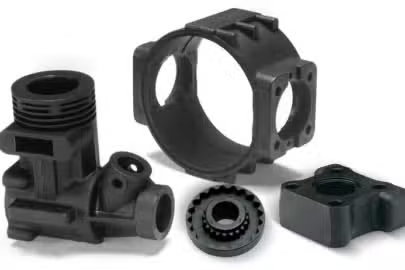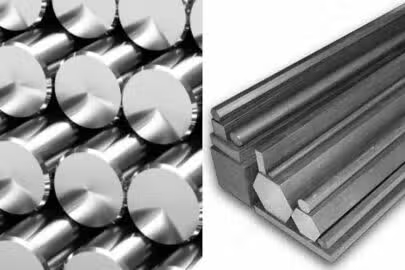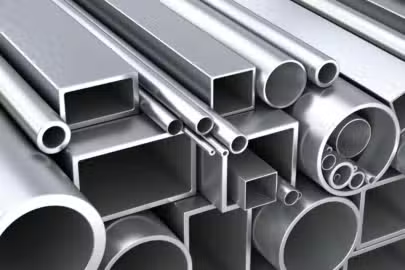Steel belongs to one of the most used alloy for manufacturing and fabrication purpose. The reason for this is its excellent mechanical properties. However, steel alloys come in different forms, with two common examples being the cold rolled and the hot rolled steel. While both are processed steel, they exhibit unique properties.
Therefore, it is important for manufacturers to understand their unique attribute to enable the select the one that best suits their project. Each steel type offers unique properties, benefits, and challenges that impact their performance, cost, and suitability for various applications.
This article explores the characteristics and differences between cold rolled steel vs hot rolled steel. However, we focussed more on their suitability for welding based on key factors, and provides practical insights to help you make an informed choice for your project.
What is Cold Rolled Steel?
Cold rolled steel is a type of steel that undergoes rolling processes below the recrystallization temperature. The steel is compressed between rollers to create a steel alloy with smoother, thinner, and more polished surface finish. The cold rolling process essentially increases the physical properties of the steel, making it better suited for high precision and tighter tolerance specifications.
In addition, cold rolling enhances the mechanical features of the steel, increasing its hardness and strength. This feature makes it ideal for applications requiring structural and high-strength steel, such as automotive panels. However, the process is expensive and may be time-consuming.
Properties of Cold Rolled Steel
The general features of cold rolled steel include the following.
- Smooth Surface Finish: The cold rolling process creates a clean, smoother, polished surface.
- High Strength: The cold rolling process is hardening, compressing the steel alloy. As mentioned, it enhances the steel alloy’s mechanical features, especially its strength.
- Dimensional Accuracy: Cold rolled steel exhibits a more uniform thickness, enhancing its ability to create parts with tighter tolerances and better dimensional accuracy.
- Reduced Ductility: Since the process compresses the metal, cold rolled steel is less malleable and flexible.
- Corrosion Resistance: Manufacturers often treat or coat cold rolled steel to improve its durability, especially in corrosive environments.
Benefits of Cold Rolled Steel
Below are some of the advantages of cold rolled steel.
- Superior Surface Quality: As mentioned, the cold rolling process reinforces the alloy’s surface features, making it suitable for applications requiring enhanced aesthetics. Unlike hot rolling, which leaves the metal with milled scales, cold rolled steels are smoother.
- Enhanced Mechanical Properties: Compared to the hot rolling process, cold rolled steel exhibits increased strength, density, and rigidity. In fact, cold rolled steel can be up to 20 percent stronger than hot-rolled steel, making it suitable for demanding applications.
- Tight Tolerances: Cold rolled steel offers precision in shapes and sizes, reducing the need for additional machining. The process enhances the metal’s dimensional accuracy, making it better suited for high-precision components.
- Durable Coating Compatibility: The resulting steel, after the cold rolling process, adheres well with paints, coatings, and galvanization.
Cons of Cold Rolled Steel
The major shortcomings of cold rolled steel include the following
- Higher Cost: Cold rolled steel may require additional processing compared to hot rolled steel, elevating its processing costs.
- Brittle Nature: The cold rolling process compresses the metal, reducing its flexibility and ductility, making it more challenging to bend or manipulate.
- Limited Thickness Options: Cold rolled steel is generally thinner, and may not be ideal for thicker or larger structural components.
What is Hot Rolled Steel?
As the name suggests, hot rolled steel is processed at high temperatures above its recrystallization point, often higher than 1700˚F, making the alloy easy to shape and form. The elevated temperature allows the material to be molded into various sizes and shapes without excessive strain, making it suitable for large-scale production of steel products like beams, plates, and sheets.
Unlike cold rolled steel, hot rolled steel has a rougher surface finish due to the cooling process and is less precise in terms of dimensions. During the cooling of the heated steel, the alloy shrinks non-uniformly, altering its shape and aesthetics. However, it is a cost-effective option for applications where surface quality and dimensional accuracy are less critical.
Properties of Hot Rolled Steel
The general features of hot rolled steel include the following.
- Lower Dimensional Accuracy: As mentioned, the steel shrinks during cooling, altering its accuracy. Therefore, hot rolled steel has less tight tolerances compared to cold rolled steel and is thus unsuitable for high-precision components.
- Rough Surface Texture: In addition to reduced tolerance standards, during cooling after the hot rolling process, oxidation occurs, leaving the steel with an inconsistent, scaly surface finish.
- High Ductility: The high temperature during processing makes hot-rolled steel more flexible, easy to bend and malleable.
- Lower Yield Strength: Hot rolled steel exhibits lower strength compared to cold rolled steel.
Benefits of Hot Rolled Steel
The advantages of hot rolled steel include the following
- Cost-Effective: The hot rolling process requires lower production costs, making it affordable for large-scale applications.
- Easily Fabricated: As mentioned, hot rolled steel is highly malleable and simple to manipulate into desired shapes.
- Wide Thickness Range: Unlike cold rolled steel, thet are available in a broader spectrum of thicknesses and sizes.
- Durable for General Use: They exhibit sufficient strength and are suitable for many industrial and structural applications.
Cons of Hot Rolled Steel
The shortcomings of hot rolled steel include the following
- Rough Surface Finish: The process creates steel parts with poor surface finish, requiring additional finishing for aesthetic or precise applications.
- Lower Dimensional Precision: The resulting steel is less suited for projects demanding tight tolerances.
- Less Strength: They are not as strong as cold rolled steel due to less work hardening.
Cold Rolled vs Hot Rolled Steel: Which One is Easier to Weld
Welding is an essential manufacturing process for joining metals, such as in an assembly. Therefore, comparing the welding suitability of two common steel variant is not far fetched. That said, whether hot rolled steel is easier to weld than cold rolled steel, or vice vera depends on several factors.
Each steel variant exhibits unique characteristics that influences its weldability under different conditions. Below are important key factors that determine their suitability for welding.
Material Strength and Hardness
The mechanical properties of a material is essential to its welding suitability. General, cold rolled steel is harder and stronger than hot rolled steel due to work hardening during the rolling process. While this feature makes cold rolled steel ideal for high-strength applications, it also means that it makes it more challenging for welding. The welder would often require higher temperature to heat the metal to just the temperature that will cause eventual fusion.
Moreover, increased hardness may lead to brittleness, especially in the heat-affected zone (HAZ), requiring careful control of heat input during welding. In contrast, in addition to hot rolled steel been softer, it is more ductile, making it less pprone to brittleness or cracking. Therefore, hot rolled steel is a better option for welding.
However, its reduced strength, compared to cold rolled steel may make it less suitable for applications that demand higher load-bearing capacities. Nevertheless, hot rolled steel is more weld-friendly due to its ductility, but cold rolled steel can also be welded with proper heat control.
Weld Penetration and Heat Conductivity
Again the mechanical properties of the steel variants comes to play. The density and hardness of cold rolled steel reduces its ability to conduct heat, requiring higher heat input for adequate weld penetration. This feature may increase the difficulty in welding this steel variant, especially achieving a deep, consistent weld in thicker sections.
On the other hand, hot rolled steel are usually denser but more ductile, allowing for easier heat penetration. Tjerefore, welders can achieve stronger and deep welds with less effort, making it more ideal for projects involving thicker or larger sections. Therefore, hot rolled steel typically offers better heat penetration, which can simplify welding, especially for heavy-duty applications.
Surface Finish and Cleanliness
As reiterated, the cold rolling process creates a steel variant with a smoother and more refined surface finish. This cleaner surface improves welding efficiency and quality, as it reduces the need for extensive pre-welding preparation. In contrast, hot rolled steel often has a rough, scaly surface due to the oxidation that occurs during cooling.
Before welding can occur, the welder must remove the scale and any surface impurity to ensure good adhesion and minimize defects like porosity. While the additional preparation time for hot rolled steel doesn’t make it unsuitable, it can increase the effort required to achieve a clean weld. Therefore, regarding the need for pre-welding surface preparation, cold rolled steel is easier to weld.
Availability and Cost
Unlike hot rolling, cold rolling requires additional processing steps. It also requires more energy since it occurs at low temperature; these factors increases its production costs. Therefore, hot rolled steel is more affordable and widely available in larger sizes and thicker sections, making it a popular choice for welding in industrial and construction projects. Its cost-effectiveness also makes it ideal for welding applications that don’t require high precision or surface aesthetics. In contrast, the increased costs associated with cold rolled steel is a limiting factor for large-scale projects. Many manufacturers will only use cold-rolled steel for welding projects with high precision demands and tight tolerance specifications.
Dimensional Precision
Again, cold rolled steel is processed with tighter tolerances and higher dimensional accuracy, which makes it ideal for welding projects requiring precise fitting. This level of precision ensures that components align properly, reducing the chances of warping or joint misalignment.
On the other hand, hot rolled steel, with its looser tolerances, may require adjustments during welding to account for dimensional inaccuracies. This can complicate the welding process, especially for applications where tight fitting is essential.
Therefore, cold rolled steel offers better dimensional stability, simplifying welding in precision-dependent projects. This feature makes it a better choice for welding high-precision parts and components.
Post-Welding Finishing
Cold rolled steel usually requires less post-welding finishing due to its cleaner surface and precise dimensions. Welded joints on cold rolled steel can be finished with minimal grinding, painting, or polishing to achieve the desired appearance. Alternatively, hot rolled steel often requires more post-welding finishing to remove scale, refine the surface, and enhance corrosion resistance. This feature may add to the overall time and cost of a welding project.
Applications and Use Cases
As reiterated, cold rolled steel is often used in applications requiring high precision and aesthetic appeal, such as automotive components, appliances, and structural framing. Its suitability for welding depends on the need for clean, precise joints that maintain strength and visual quality.
On the other hand, hot rolled steel is common in structural applications, such as beams, columns, and industrial machinery, where surface finish and precision are secondary concerns. Its ductility and ease of welding make it a go-to material for heavy-duty construction.
Contrast Table
The table below gives a summary but concise differences between cold rolled steel vs hot rolled steel. Let’s get right into it.
| Criteria | Cold Rolled Steel | Hot Rolled Steel |
| Production Process | Rolled at relatively low temperature, creating steel with tighter tolerances and smoother finish. | Rolled at high temperatures (above 1700°F), followed by rapid cooling, causing scale formation. |
| Surface Finish | Smooth, clean, and polished surface with no scale. | Rough, scaly surface due to oxidation during cooling. |
| Dimensional Precision | High precision with tighter tolerances. | Looser tolerances, less precise dimensions. |
| Material Strength | Higher strength and hardness due to work hardening. | Lower strength but higher ductility. |
| Ease of Welding | Requires careful heat control due to potential brittleness in the heat-affected zone. | Easier to weld due to its ductility and reduced risk of cracking. |
| Applications | Used for precision and aesthetic projects like appliances and automotive parts. | Ideal for simple to structural applications like beams, columns, and machinery, with less precision demands. |
| Cost | More expensive due to additional processing and precision. | Cheaper and widely available in larger sections. |
| Post-Welding Finishing | Requires minimal finishing, as the surface is already clean and polished. | Needs extensive finishing to remove scale and improve surface quality. |
Cold Rolled Steel vs Hot Rolled Steel: Which Should I Choose?
We already examined the differences between cold rolled and hotr rolled steel, relating to their welding suitability. This section focuses on factors to consider when deciding on which of the steel variant fits your project’s specific requirements.
Dimensional Precision
If your project demands precise measurements and tight tolerances, such as in appliances, automotive components, or intricate tools, cold rolled steel is ideal. Its controlled production process ensures accuracy and a refined finish. Moreover, it minimizes the need for post-processing operations.
Budget and Cost Implications
When on budget constriants, or dealing with cost-sensitive projects or applications requiring bulk materials, hot rolled steel is a more economical choice. Its simpler production process reduces overall costs, making it suitable for large-scale construction or machinery.
Aesthetic Requirements
We have already reiterated that cold rolled steel has better appearance. Therefore, projects that prioritize appearance, like furniture, signage, or decorative pieces, benefit from the smooth and polished surface of this steel variant. In contrast, hot rolled steel requires additional finishing for a comparable aesthetic.
Structural Strength vs Ductility
For applications requiring strength and hardness, such as machine parts or high-performance tools, choose cold rolled steel. On the other hand, hot rolled steel is better suited for structural projects where flexibility and ductility are key, like bridges or frames.
Ease of Welding and Post-Welding Processes
As hinted above, if welding is a central part of the project, hot rolled steel is easier to work with due to its ductility. However, if minimal post-weld finishing is essential, cold rolled steel may be a more viable option.
Zintilon: Your Expert Manufacturing Partner
Are you in need of a reliable, third-party manufacturing service provider? Look no more; Zintilon offers services in various part manufacturing and fabrication services. Whether its CNC machining, die casting, or sheet metal fabrication, we deliver quality fabrication at competitive pricing.
Do not hesitate to contact us today for your next manufacturing gig.
Conclusion
Choosing between cold rolled and hot rolled steel comes down to understanding your project’s specific requirements. While hot rolled steel offers cost efficiency and ease of welding, cold rolled steel excels in precision and surface quality. Each steel type has distinct advantages and limitations, making it essential to weigh factors like weldability, aesthetics, and budget. By carefully considering these aspects, you can select the material that ensures optimal performance and long-term success for your project.
Great, Together



